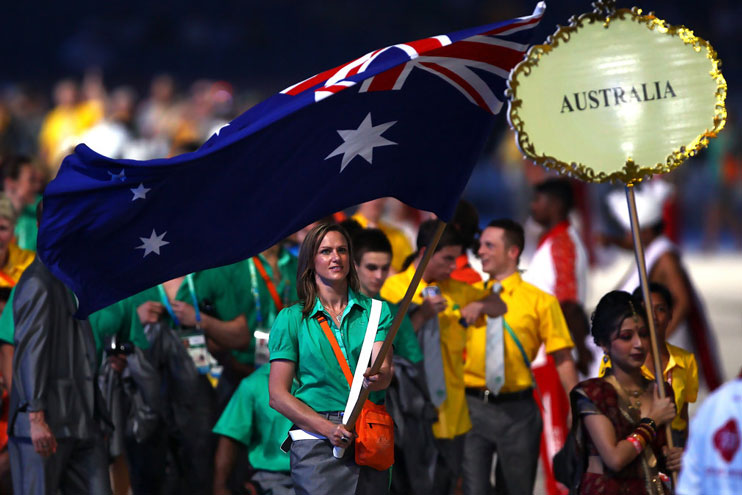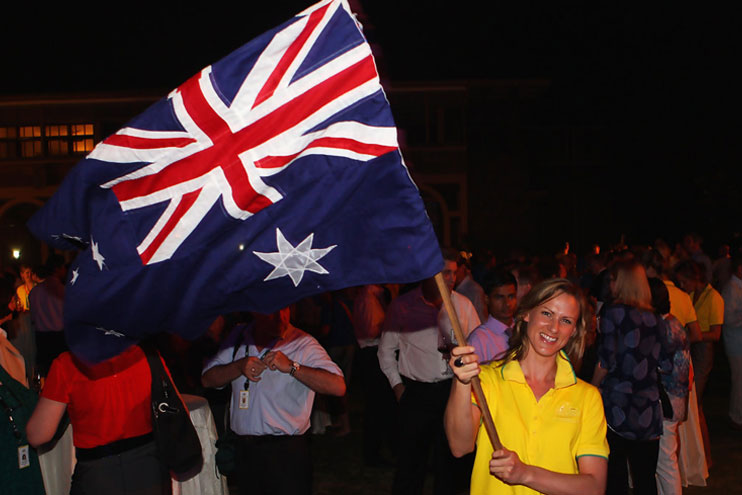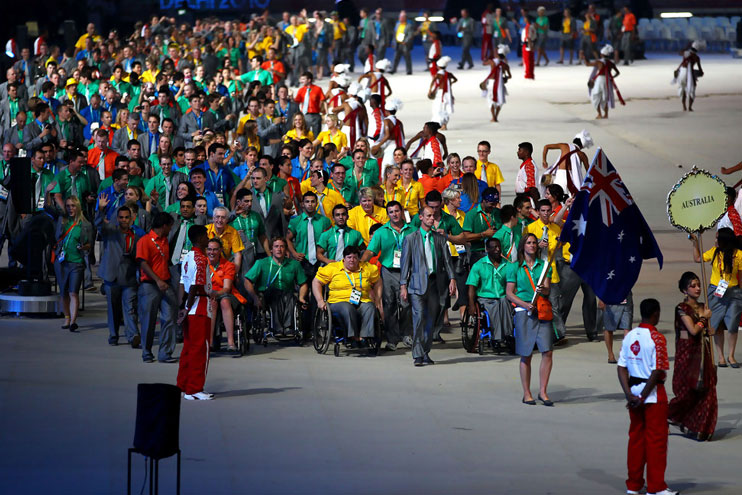
October 3rd marks the 10-year anniversary of the Delhi 2010 Commonwealth Games, Ian Hanson caught up with Australian Team opening ceremony flagbearer Sharelle McMahon to reflect on the moment and the Games in India.
By Ian Hanson
Four-time Commonwealth Games representative Sharelle McMahon stands tall as one of Australian netball’s shining lights, a former Diamonds captain and goal shooter who now holds a special place in the annals of Commonwealth Games history – as the first team sport athlete to carry the flag in the Opening Ceremony.
McMahon has never forgotten the moment she was standing alongside her teammates at the Team Reception for the 2010 Commonwealth Games team in Delhi.
“We were all at the team reception the day before the Opening Ceremony and I thought I was just one of the hundreds of athletes attending and getting excited for the competition to get going,” McMahon recalled.
“And that’s when they announced the flag bearer and I had absolutely no idea that it was going to be me until they announced it up on stage.
“My reaction was ‘oh my goodness I can’t believe this’… who me?
“I had no idea at all that was going to be happening prior to that but looking back on it – what a cool way to do it?
“And the first team sport athlete to carry the flag; that was really special for me as well, a great honour.”

Chef de Mission Steve Moneghetti with Opening Ceremony flagbearer Sharelle McMahon (CGA Archives)
“It was also a recognition for netball and all the team sport athletes and that it had not been done before;
another layer of recognition for the team sports.“I still have to pinch myself; not many people have the honour of carrying the flag and when I joined the other 10 former flag bearers with 2018 flag bearer Mark Knowles on the Gold Coast it was so good.”
“It was such a great thing to see that and just how significant it has been.”
With Anna Meares chosen to carry the flag in Glasgow in 2014 (becoming the fifth woman in the 70-year history of the Games to lead the team for the Opening Ceremony), the prestigious role and honor is bestowed upon the person recognised as the athlete leader of the Australian team. In 2010 it was chosen by Chef de Mission Steve Moneghetti.
“I didn’t let Sharelle know before hand but I had to make some discreet inquiries to make sure she was going to be there, that was important,” said Moneghetti.
“And when I made the announcement, she was happily surprised which I loved.
“Sharelle was very humble and a bit overcome, actually a little stunned, shocked and understated.
“As the flag bearer she became the designated team leader and with that comes a lot of responsibility.
“Sharelle had to look after her own team performance as captain of the netball team and the whole team as well for the duration of the Games and she took on that job with great distinction and did a fantastic job.”

Sharelle with the flag after being announced as the Opening Ceremony flagbearer (CGA Archive)
Triple Commonwealth Games hurdles gold medallist Pam (Kilborn) Ryan has also been remembered this year as our first female flag bearer at the 50th anniversary of the Edinburgh Games.
She followed eight men since rowing ace Henry “Bobby” Pearce carried the flag at the first British Empire Games in Hamilton, Canada, in 1930.
And after a 20-year wait swimmer Lisa Curry-Kenny carried the flag in Auckland in 1990, with walker Jane Saville in Melbourne in 2006, the first of three successive female flag bearers.
But little did Sharelle know what she was getting herself in for at an Opening Ceremony that could well have ended in disaster with the Australian team virtually trapped in the entry tunnel, sweating and struggling to breathe, many athletes near collapse.
“It felt like we stepped out of the shower; that’s how hot we were; we were so wet; it wasn’t like we were just perspiring; it was nothing like we had ever experienced before,” McMahon recalled.
“We were waiting for a long time and moved forward into a tunnel leading towards the main stadium and I was of course right at the front with hundreds of athletes behind and it was almost unbearable.
“We were standing at the rear of the tunnel waiting to go on and actually getting blasted by hot air from the ‘air conditioners.’
“It was certainly getting towards being a little scary and it was certainly tense and people were getting very agitated and frustrated.
“And I thought if they start to panic this can get very dangerous and at the front of the line we could absolutely feel that happening.
“It got to the point where we just had to go and when we got to the entrance to the main stadium it was like a burst into the vaguely fresh Delhi air which was (kind of) fresh compared to the air we had in the tunnel.
“But looking back, leading the Australian team onto the stadium was still a pretty incredible experience; to head out there with the team behind me it was one of the really special moments in my career.
“It felt like 50m it went so quickly, but it was something that could have been an absolute disaster… something I will look back on as a part of my story.”

Australian Team at the Opening Ceremony (CGA Archives)
McMahon’s Commonwealth Games career had started out in Kuala Lumpur in 1998 when she was part of the gold medal winning team when netball was included in Games for the first time.
And along with captain Vicki Wilson it was McMahon who netted one of the final two goals in a gripping 42-39 win over Trans Tasman rivals New Zealand – a closeness trend that would continue in the next big finals.
Four years later in Manchester it was a successful defence for the Diamonds in another nail-biting final, with Australia again getting the better of the Kiwis, 57-55 after sudden death extra-time.
But fortunes favoured New Zealand in Melbourne with a strong 60-55 win over Australia before the two arch rivals played out the longest netball final in history in Delhi, with the Kiwis winning 66-64 after ten minutes of the second period of extra-time.
“You reflect on the final game and think of little things that maybe if I’d done this or done that,” McMahon reflected.
“But one memory I do have is thinking that New Zealand superstar Maria Tutaia, who had been landing these long range goals and having a blinder, surely she had to miss sooner or later.
“But she didn’t miss and she fired off the goals that won the game – it was like she had ice in her veins.”
“It makes us all realise just how lucky we were to win those tight games in 1998 and 2002 so many of these big finals have gone into extra-time.”
And as it turned out Delhi was certainly a milestone Games for Australia’s female athletes with swimmer Alicia Coutts chosen to carry the flag at the Closing Ceremony after her five gold medal haul; and the performances of both Sally Pearson (who won her first international gold medal in the 100m hurdles) and cycling superstar Anna Meares (who won three gold at the velodrome).
“There was certainly an emergence of female sport in Australia at that time and now it is something that is front and centre,” Moneghetti said.
“But this was 10 years ago and this was a significant time.
“With Sharelle being the first from a team sport as the flag bearer and Alicia carrying the flag in the Closing after her golden haul, and then Sally and Anna Meares dominating– they all went to the London Olympics in 2012 and won gold medals.
“In fact the results from some of our females were outstanding – very unusual having females carrying the flag at the Opening and Closing – Delhi with all its issues was quite a turning point for women’s sport in Australia,” Moneghetti concluded.
